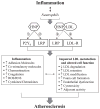Human neutrophil peptides: a novel potential mediator of inflammatory cardiovascular diseases
- PMID: 18805897
- PMCID: PMC4896811
- DOI: 10.1152/ajpheart.00472.2008
Human neutrophil peptides: a novel potential mediator of inflammatory cardiovascular diseases
Abstract
The traditional view of atherosclerosis has recently been expanded from a predominantly lipid retentive disease to a coupling of inflammatory mechanisms and dyslipidemia. Studies have suggested a novel role for polymorphonuclear neutrophil (PMN)-dominant inflammation in the development of atherosclerosis. Human neutrophil peptides (HNPs), also known as alpha-defensins, are secreted and released from PMN granules upon activation and are conventionally involved in microbial killing. Current evidence suggests an important immunomodulative role for these peptides. HNP levels are markedly increased in inflammatory diseases including sepsis and acute coronary syndromes. They have been found within the intima of human atherosclerotic arteries, and their deposition in the skin correlates with the severity of coronary artery diseases. HNPs form complexes with LDL in solution and increase LDL binding to the endothelial surface. HNPs have also been shown to contribute to endothelial dysfunction, lipid metabolism disorder, and the inhibition of fibrinolysis. Given the emerging relationship between PMN-dominant inflammation and atherosclerosis, HNPs may serve as a link between them and as a biological marker and potential therapeutic target in cardiovascular diseases including coronary artery diseases and acute coronary syndromes.
Figures

Similar articles
-
Human neutrophil alpha-defensins induce formation of fibrinogen and thrombospondin-1 amyloid-like structures and activate platelets via glycoprotein IIb/IIIa.J Thromb Haemost. 2012 Apr;10(4):647-61. doi: 10.1111/j.1538-7836.2012.04640.x. J Thromb Haemost. 2012. PMID: 22268819
-
α-Defensins partially protect human neutrophils against Panton-Valentine leukocidin produced by Staphylococcus aureus.Lett Appl Microbiol. 2015 Aug;61(2):158-64. doi: 10.1111/lam.12438. Epub 2015 Jun 1. Lett Appl Microbiol. 2015. PMID: 25963798
-
Increased alpha-defensin expression is associated with risk of coronary heart disease: a feasible predictive inflammatory biomarker of coronary heart disease in hyperlipidemia patients.Lipids Health Dis. 2016 Jul 18;15:117. doi: 10.1186/s12944-016-0285-5. Lipids Health Dis. 2016. PMID: 27430968 Free PMC article.
-
Role of inflammation in the pathogenesis of atherosclerosis and therapeutic interventions.Atherosclerosis. 2018 Sep;276:98-108. doi: 10.1016/j.atherosclerosis.2018.07.014. Epub 2018 Jul 25. Atherosclerosis. 2018. PMID: 30055326 Review.
-
Neutrophil Extracellular Traps Participate in Cardiovascular Diseases: Recent Experimental and Clinical Insights.Circ Res. 2020 Apr 24;126(9):1228-1241. doi: 10.1161/CIRCRESAHA.120.315931. Epub 2020 Apr 23. Circ Res. 2020. PMID: 32324499 Free PMC article. Review.
Cited by
-
Role for TNF in atherosclerosis? Lessons from autoimmune disease.Nat Rev Cardiol. 2009 Jun;6(6):410-7. doi: 10.1038/nrcardio.2009.57. Nat Rev Cardiol. 2009. PMID: 19421244 Review.
-
Neutrophil (dys)function due to altered immuno-metabolic axis in type 2 diabetes: implications in combating infections.Hum Cell. 2023 Jul;36(4):1265-1282. doi: 10.1007/s13577-023-00905-7. Epub 2023 Apr 28. Hum Cell. 2023. PMID: 37115481 Free PMC article. Review.
-
The kynurenine system and immunoregulation.J Neural Transm (Vienna). 2012 Feb;119(2):197-209. doi: 10.1007/s00702-011-0681-y. Epub 2011 Jul 9. J Neural Transm (Vienna). 2012. PMID: 21744051 Review.
-
Characterization of Antimicrobial Peptides toward the Development of Novel Antibiotics.Pharmaceuticals (Basel). 2013 Aug 21;6(8):1055-81. doi: 10.3390/ph6081055. Pharmaceuticals (Basel). 2013. PMID: 24276381 Free PMC article.
-
Chemokines and Their Receptors Are Key Players in the Orchestra That Regulates Wound Healing.Adv Wound Care (New Rochelle). 2013 Sep;2(7):327-347. doi: 10.1089/wound.2012.0380. Adv Wound Care (New Rochelle). 2013. PMID: 24587971 Free PMC article. Review.
References
-
- Aarbiou J, Rabe KF, Hiemstra PS. Role of defensins in inflammatory lung disease. Ann Med. 2002;34:96–101. - PubMed
-
- Adams DH, Shaw S. Leucocyte-endothelial interactions and regulation of leucocyte migration. Lancet. 1994;343:831–836. - PubMed
-
- Adrie C, Laurent I, Monchi M, Cariou A, Dhainaou JF, Spaulding C. Postresuscitation disease after cardiac arrest: a sepsis-like syndrome? Curr Opin Crit Care. 2004;10:208–212. - PubMed
-
- Ashitani J, Mukae H, Hiratsuka T, Nakazato M, Kumamoto K, Matsukura S. Elevated levels of alpha-defensins in plasma and BAL fluid of patients with active pulmonary tuberculosis. Chest. 2002;121:519–526. - PubMed
-
- Assmann G, Carmena R, Cullen P, Fruchart JC, Jossa F, Lewis B, Mancini M, Paoletti R. Coronary heart disease: reducing the risk: a worldwide view. International Task Force for the Prevention of Coronary Heart Disease. Circulation. 1999;100:1930–1938. - PubMed
Publication types
MeSH terms
Substances
Grants and funding
LinkOut - more resources
Full Text Sources

